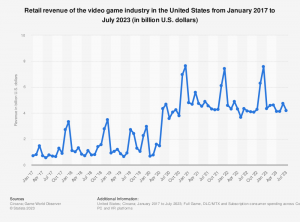Recent Study Highlights Significant Surge in Retail Revenue and Emerging Trends in the Video Game Sector
ISTANBUL, TURKEY, November 8, 2023 /EINPresswire.com/ — A newly released report illuminates the substantial growth in the U.S. video game industry’s retail revenue, leaping from $14.51 billion in 2017 to an impressive $60.16 billion in 2021. This comprehensive analysis, covering the period up to July 2023, provides a detailed examination of the factors influencing the industry’s revenue generation and highlights future predictions and trends.
In an era where digital entertainment has taken a forefront, the video game industry’s evolution is significant. The industry’s steady revenue growth in the pre-pandemic years was catapulted to new heights in 2020, likely due to the COVID-19 pandemic, and has since seen a pattern of stabilization.
Distribution of Game Industry Revenues by Years
Video game industry retail revenue in the U.S. breakdown by year was as follows.
2017-2019: Consistent growth, with revenues rising to $18.27 billion in 2019.
2020: A dramatic surge brought in $43.83 billion.
2021: A peak of $60.16 billion was reached.
2022: A slight dip indicated market corrections, closing at $56.59 billion.
2023 (up to July): An anticipated annual projection around $52.7 billion.
Transition to Digital and the Shift in Retail
The report underscores a pivotal trend towards digital purchases. However, retail still plays a critical role, particularly in gaming accessories sales.
Factors Influencing Revenue Trends
•Consumer Expenditure Trends: As of November 2022, over 40% of gamers in the United States showed a willingness to invest $41 to $60 when purchasing a video game. This inclination, alongside the notable preference among many mobile gamers for complimentary games, reflects a complex picture of the video gaming expenditure landscape.
•Yearly Expenditure Insights: In 2022, U.S. customers allocated $47.5 billion to video game content, which indicates a 7% decline from the $51.69 billion spent in the prior year.
•Strategic Release Scheduling: Major players in the gaming industry, such as EA with its newly rebranded FIFA series and Activision Blizzard with its Call of Duty franchise, often target the profitable holiday months of November and December for their releases. The closing months of 2023 are set to be exciting, with anticipated titles including Baldur’s Gate 3, Starfield, the Cyberpunk 2077: Phantom Liberty expansion, Assassin’s Creed Mirage, Marvel’s Spider-Man 2, the Nintendo Switch version of Hogwarts Legacy, and Honkai Star Rail for the PS5.
The Role of eSports in the U.S. Video Game Industry
eSports has transitioned from a niche to a leading force within the industry, contributing economically through sponsorships, prize pools, and streaming rights. Its mainstream adoption and the resulting influence on game development, infrastructure, academia, and career opportunities underscore its significant role.
Challenges and Opportunities.
Difficulties
•Market Oversaturation: The continuous release of new games each year floods the market, diminishing the visibility and impact of individual titles.
•Elevated Production Expenses: The creation of high-caliber games demands significant investment, heightened by the rising expectations for visuals, storytelling, and game mechanics.
•Copyright Infringement: Unauthorized downloading and distribution severely undercut potential earnings.
•Regulatory Hurdles: Keeping pace with the shifting landscape of laws and standards, particularly those affecting content and revenue models, poses a complex challenge.
•Health-Related Critiques: The industry is scrutinized for its possible negative effects on both mental and physical health, including addiction and inactive lifestyles.
Prospects:
•Cutting-Edge Tech: The emergence of virtual and augmented reality, as well as advances in AI, presents new frontiers for creative gameplay.
•Interconnectivity in Gaming: The push for gameplay that spans various devices is creating openings for titles that break platform barriers.
•Expanding Player Base: The increasing appetite for games that appeal to a broader audience calls for narratives that are both inclusive and diverse.
•Games for Learning and Healing: Video games are gaining recognition for their benefits in educational and therapeutic contexts, aiding in everything from mental agility to physical recovery.
•Content Streaming and Creation: Channels like Twitch and YouTube provide fertile grounds for both game creators and players, prolonging the life of games and fostering vibrant communities.
Looking to the Future
The video game industry is set for further evolution. Despite a move towards stabilization, upcoming high-profile releases in the 2023 Christmas season may introduce new trends and shifts.
Conclusion
This report’s findings on the U.S. video game industry retail sector from 2017 to 2023 reveal a landscape of growth, unexpected surges, and stabilization, offering a lens through which consumer behavior and global market events can be understood. As we advance, the sector remains ripe for innovation and excitement.
Yıldırım Sertbaş
Gamevcore.com
+90 553 968 91 06
[email protected]
Visit us on social media:
Facebook
Twitter
Instagram
YouTube
Other
![]()
Originally published at https://www.einpresswire.com/article/667056968/the-evolution-of-retail-revenue-in-the-u-s-video-game-industry-2017-2023





